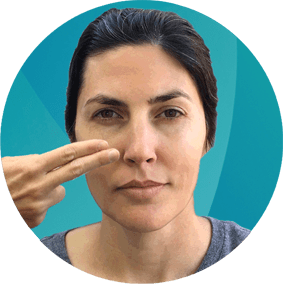What’s blocking air from traveling through your nose?

When air can’t travel through your nose, preventing you from adequately breathing, your health is at risk, and you’re forced to only breathe from your mouth. It can impact your ability to sleep, lead to bad breath, affect your confidence and energy, and more. Simply put, a blocked nasal airway is a problem worth solving.
Are enlarged turbinates getting in the way of your nasal airway? Continue reading below to learn how turbinates may be impacting your breathing and what to do next, or take action today and schedule your appointment with Southern Indiana ENT.
What are turbinates and how can they block your nasal airway?
A turbinate, also known as a nasal concha, helps filter, warm and humidify the air you breathe. Most humans have three turbinates (superior, middle, inferior). Your turbinates can be found inside the nose, and are made of a combination of bone and tissue (mucosa).
Due to their location inside your nose, turbinates obstruct your nasal airway. This is not usually a problem that prevents enough air from entering and exiting your nose. However, when turbinates enlarge, which does not happen without a cause, the available space for air to travel through your nose decreases and you may no longer be able to breathe properly.
Why do turbinates expand?
When turbinates expand and enlarge, it’s referred to as “turbinate hypertrophy.” This condition is caused by several health issues, including:
- Allergies
- Common cold
- Sleep apnea (obstructive)
- Irritants (pollution, chemicals, perfumes, dust, tobacco)
- Collapsed nasal valve
- Chronic sinus inflammation
- Dysfunction of the auditory tube
- Concha bullosa
- Choanal atresia
To reverse the nasal breathing issues caused by enlarged turbinates, your Ear, Nose, and Throat (ENT) doctor may recommend a turbinate reduction procedure.
Are you a candidate for turbinate reduction?
To know for sure if you could benefit from a turbinate reduction procedure, you should consult with your ENT. As a patient of Southern Indiana ENT, you will be treated with care while our doctors analyze your symptoms and examine your nose to determine if you are a candidate for a turbinate reduction procedure.
Although you cannot determine if your turbinates need to be reduced on your own, you can rule them out as the cause of your nasal breathing issues by performing the Cottle Maneuver at home.
Performing the Cottle Maneuver: Why and How

The Cottle Maneuver is a test that will reveal if your turbinates are not causing the trouble you’re having breathing from your nose. It is a simple, at-home test that will quickly give you information on the cause of your issue.
To perform the Cottle Maneuver, take the following 4 steps:
- Press the tips of two fingers on your cheeks near your nose
- Gently pull your cheeks towards your ears (this should open your nasal valve)
- Take a deep breath in through your nose
- Concentrate on your breathing and take note if it has improved or stayed the same
Has your breathing improved? If performing the Cottle Maneuver temporarily improves your breathing significantly, enlarged turbinates are not likely to be the cause of the blockage in your nasal airway. Schedule your appointment with Southern Indiana ENT to learn what is the cause of your issue and your options for relief.
Your Relief Options from Enlarged Turbinates with Southern Indiana ENT
If turbinates are obstructing your nasal airway, an ENT can guide you through your options and determine which will be the best fit for your life, body, and wants and needs. South Indiana ENT seeks minimally-invasive, long-term relief solutions when possible.
Turbinate reduction procedures include the following:
- Radiofrequency Turbinate Reduction (RFTR) (minimally-invasive)
- Turbinate “smashing” (minimally-invasive)
- Collapsing the turbinates
- Endoscopic sinus surgery
Minimally-invasive solutions can be performed in a surgery center or from one of our convenient locations in Indiana (Columbus, Seymour, Franklin). Turbinate collapsing procedures and endoscopic sinus surgeries are performed in a surgery center and take several weeks to recover from fully.
Finding your solution and gaining peace of mind is one appointment away with Southern Indiana ENT.
Enlarged turbinates are a common and troublesome condition that makes getting enough oxygen through your nose nearly impossible. Southern Indiana ENT is experienced in treating enlarged turbinates and clearing blocked nasal airways.
South Indiana ENT has and provides the following:
- State-of-the-art sinus, allergy, sleep and hearing services
- Decades of experience
- Compassionate care
- Commitment to exceed your expectations
Don’t allow your turbinates to block your nasal breathing and interrupt your life!
Turbinate reduction can remove the blockage in your airway and allow you to once again breathe with ease and without worry.
Contact us to see if you are a candidate for turbinate reduction.

